As a graduate student affiliated with the UCMP, there are many resources readily available to me. Not only does the museum have the largest university research collection, but the curators, museum scientists, and staff are some of the most knowledgeable and helpful anywhere. UCMP is recognized for taking care of its graduate students, and one of the ways they do it is by providing multiple funding opportunities. I applied to UCMP for funding last year in order to conduct museum travel for my research and I was fortunate to get an award from the Welles Fund.
One major aspect of my research focuses on looking at shape differences in the skulls of monitor lizards. Monitor lizards, or varanids, are generally thought of as being fairly large lizards (e.g., Komodo dragon), but some may be no longer than a pencil. Although there are many extinct species and genera within this group, there are approximately 70 living species in the single genus Varanus. They live in Africa, Southern Asia, and Australia, and are ecologically versatile, with some being strictly terrestrial, arboreal, or even semi-aquatic. Fossil varanids from Asia may be as much as 90 million years old; varanid fossils are also found in North America and Europe.

Thanks to my Welles Fund award, last year I was able to visit the American Museum of Natural History in New York, The Yale Peabody Museum in New Haven, CT, and the Australian Museum in Sydney, Australia. At these museums I photographed the skulls of over 300 modern varanid skulls, getting top, side, and bottom views of each. I use these photos for a technique called Geometric Morphometrics. Morphometrics (greek “morphe” or shape, and “metria” or measurement) is a general term used for describing the quantification of shape. Many fields within biology use this technique to study numerous questions, like changes from juvenile to adult morphologies, how ecology influences shape, and in my case, comparing species from different regions to each other and to those in the fossil record. Geometric Morphometrics is a technique that uses landmarks (coordinates) placed on photos of specimens that can be regarded as a a similar point in each specimen in the study. There are various ways of analyzing the data, but essentially the locations of the landmarks on different specimens are compared and quantified. One main analysis conducted with this data is called Principal Component Analysis which tells you where the maximum amount of variation in your specimens happens to be. This allows the researcher to determine how much shape difference exists in their specimens of interest. In my case, museum visits are essential since they allow for adequate sample sizes to compare the species found in different locations of this group.

I was able to analyze the data to answer various questions, and one of the most interesting discoveries was that the varanids in Africa, where there are only about six species, are almost as morphologically variable as those in, for example, Australia where there are approximately 30 species (depending on where you designate certain groups). I am continuing to analyze and collect data, but I am thankful to the UCMP for providing the finanical assistance necessary for me to complete a large portion of my dissertation project. As a side benefit, traveling to distant museums allowed me to visit interesting and beautiful locations!
